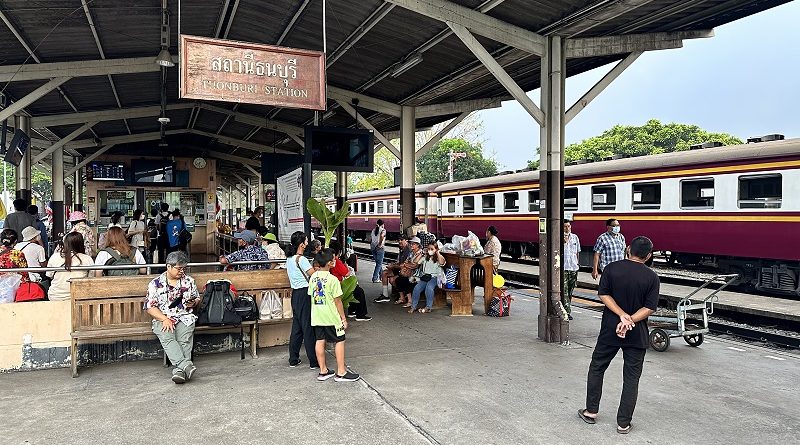
How to go by train along the Death Railway
Thonburi Station is the departure point for trains to Kanchanaburi along the Death Railway. Two trains operate daily: Local Train No. 257 departs at 7:45 a.m., and No. 259 departs at 1:55 p.m. If you’re returning on the same day, catch the earlier train. The fare for foreigners is 100 Baht, regardless of the distance travelled.
You can also take a bus Kanchanaburi and then get on near the Bridge on the River Kwai. To be honest, the first two and a half hours on the train are not that interesting. But you won’t be able to say you have been on the entire Death Railway line if you do that.
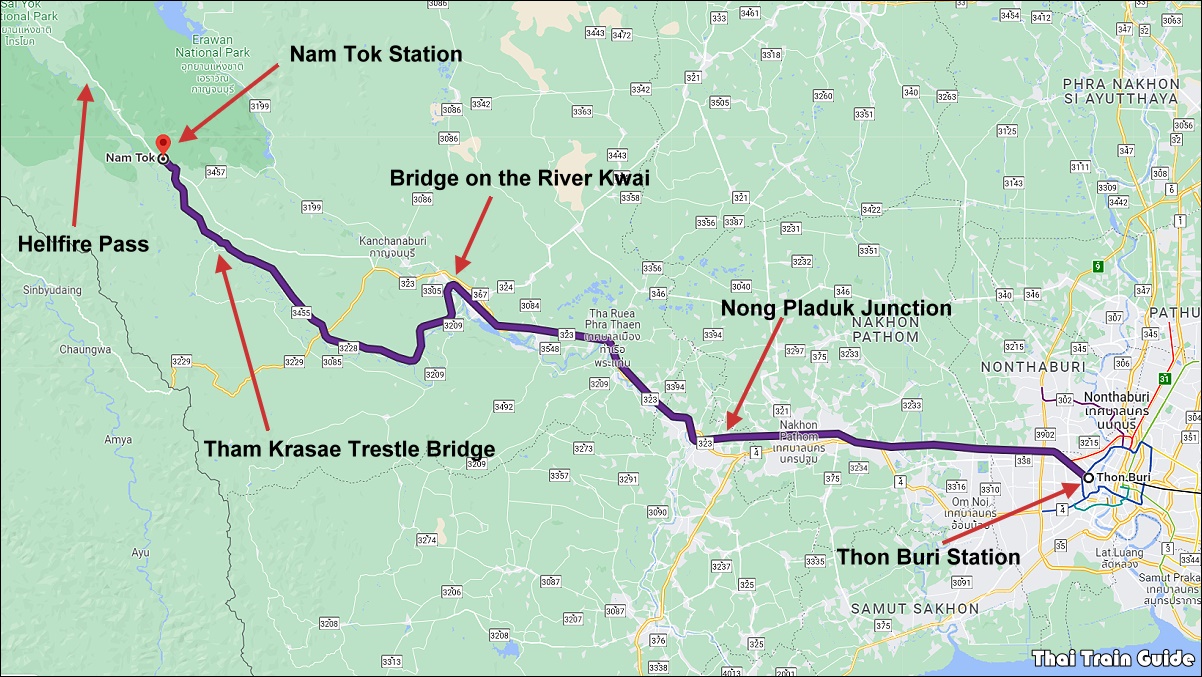
Tickets cannot be purchased online or in advance, so arrive at the station about 30 minutes before departure and buy them at the ticket office. Don’t worry about tickets selling out. If you are coming here by boat, head to the Thonburi Station Pier in front of Siriaj Hospital. The station is behind the hospital. There are several places near the station to grab breakfast or coffee if you are early.

This is the diesel locomotive that will transport you to Kanchanaburi. At this terminal station, there are multiple trains awaiting departure, so be sure to board the correct one. Look for the train with the destination sign ‘Thonburi – Nam Tok’. In Thai, ‘Nam Tok’ means waterfall. The current terminus of the Death Railway is near Sai Yok Noi Waterfall.

The train consists only of 3rd class carriages with fans and open windows. You can choose any available seat, as they are not assigned. The train is a bit mismatched, so it’s a good idea to walk through the carriages until you find a comfortable seat.
For the best views after Kanchanaburi town, try to get a window seat on the left-hand side of the train, facing the direction of travel. Also, make sure there is a working fan above you. While the open window provides natural air conditioning when the train is moving, delays can make it hot without the fan.

The first point of interest on the Thai-Burma Railway is Nong Pladuk Junction Station. This is the official starting point of the railway. If you are on the morning train, you will arrive at Nong Pla Duk Junction Station at 9:16 a.m. As you look out of the right-hand side of the train, you will see a boulder with an inscription commemorating the start of construction on September 16, 1942. If you are on the afternoon train, you will arrive at Nong Pla Duk Junction Station at 3:21 p.m.
Shortly after departing Nong Pla Duk Junction Station, the train will transition from the Southern Line onto the branch line leading to Kanchanaburi. There is also another branch line here that leads to Suphanburi.

Kanchanaburi Railway Station is the first major stop on the journey. The morning train arrives at 10:20 a.m., and the afternoon train arrives at 4:19 p.m. You could disembark here and spend a night or two in Kanchanaburi town before continuing the journey on another day. However, keep in mind that many people board the train at this station, so you may not get a window seat on the left-hand side.

About fifteen minutes after passing Kanchanaburi Station, you will arrive at the infamous Bridge on the River Kwai. This is the original bridge that was built during World War II. The concrete pillars still show signs of shrapnel damage, and the middle section was destroyed by Allied bombers. The curved arches at each end remain in their original form, but the straight ones in the middle were added after the war.
To the left of the bridge, about 100 meters away, there used to be a temporary wooden bridge. This was the precursor to the more permanent structure. However, the wooden bridge was dismantled after the war, and nothing remains today except for a short replica displayed in a nearby museum.

This is the view you get of the Bridge on the River Kwai while crossing it on a train. If you have time, I recommend riding the train and watching it cross the bridge from the trackside. On my last trip here, I stayed in a hotel near the bridge on the second night. You can either get off at the halt before the bridge or come back later and stay overnight.
RELATED LINK: Times For Taking Photos Of Trains On The Bridge On The River Kwai

The next point of interest is a cutting constructed by prisoners of war. It is not as long or dramatic as Hellfire Pass, but it is still significant. The cutting is located near Chungkai War Cemetery, which was once a prisoner of war camp. It can be reached within ten minutes of crossing the bridge.
To find the cutting, look for the black telegraph poles on the left-hand side of the train tracks. Each pole is marked with a number, which serves as a kilometer marker. Your target is pole 125/3, which is the third pole after the 125-kilometer marker. The cutting is straight after this pole.
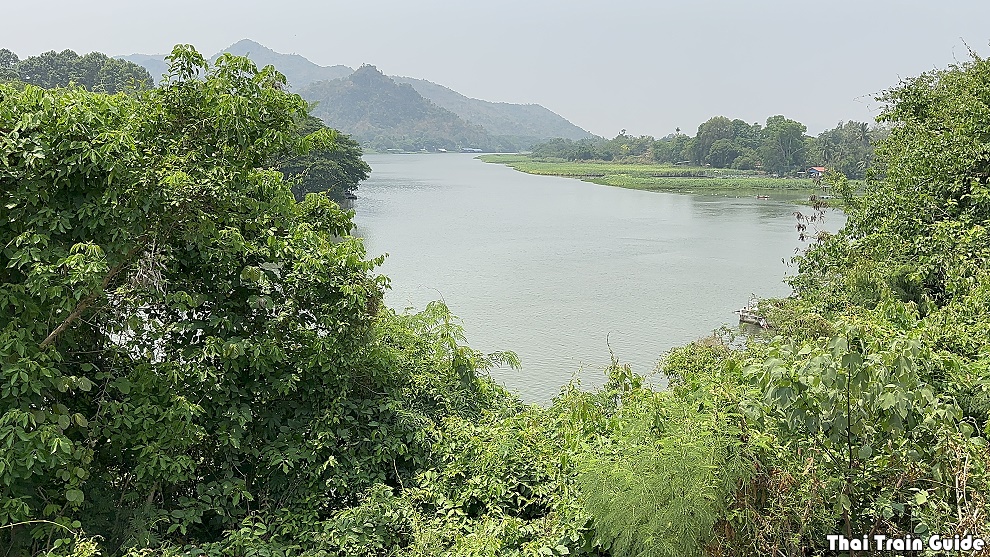
After the cutting, you will have a clear view of the Khwae Noi River on your left. The bridge you crossed earlier spans the Khwae Yai River, a separate tributary to the Maeklong River that eventually reaches the sea. “Yai” means “big” and “Noi” means “small” in Thai. The River Kwai in the movie was mispronounced; it should actually be Khwae, which rhymes with “square.”
RELATED LINK: Is It The River Kwai Bridge Or River Khwae Yai Bridge Or Maeklong Bridge?
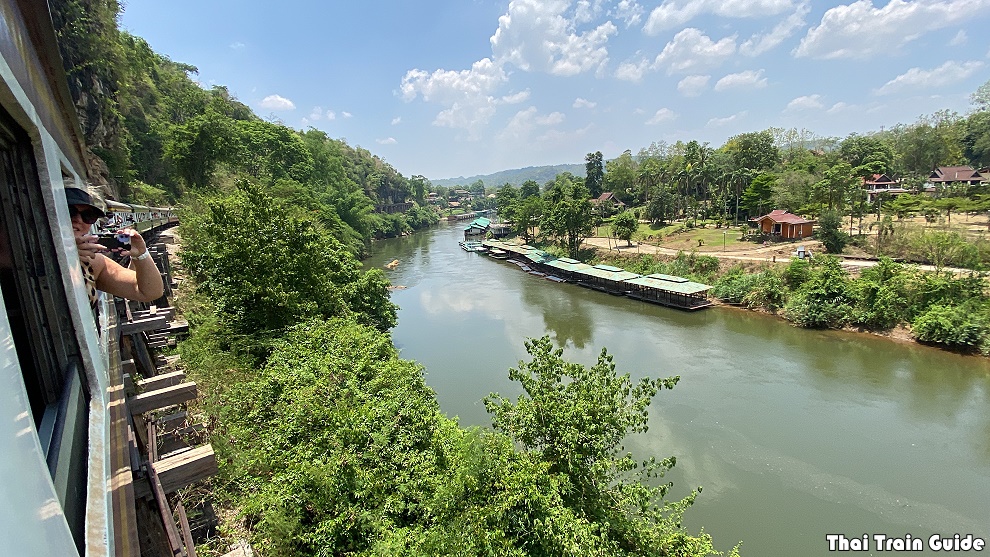
One of the highlights of this train journey is crossing the Tham Krasae wooden viaduct. This impressive structure runs alongside a cliff above the Khwae Noi River, just over an hour from the River Kwai Bridge.
Keep an eye out for telegraph pole 173/17 on your left. As the train approaches the viaduct, it slows to a crawl due to occasional tourists walking on the track. Please be careful while on the train, as there have been accidents in the past. Not long ago, someone fell to his death from the train.

After the wooden viaduct at Tham Krasae Halt, you have the option to get off and explore. I’ve done it a few times, and I recommend it. There is an interesting cave there, and you can also walk across the wooden viaduct. Just be sure to check the train schedule beforehand. However, the engineer will sound the horn as he approaches. On weekends, there are also special excursion trains. If you decide to stay overnight, there are several riverside resorts to choose from.
RELATED LINK: Times For Taking Photos Of Trains On The Tham Krasae Wooden Trestle Bridge
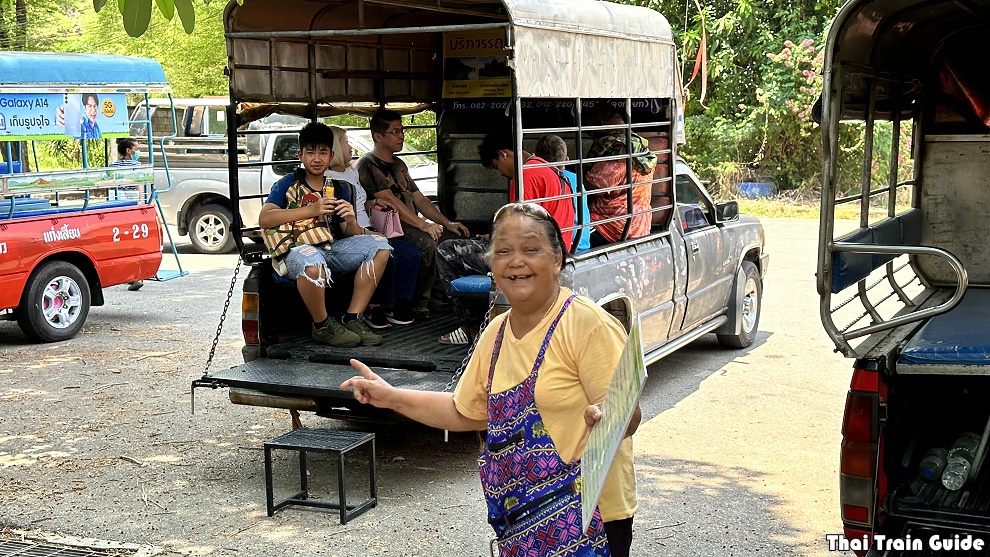
After Tham Krasae, the train continues to climb into the hills, offering scenic views. Occasionally, there are breaks in the vegetation, and you can see the river below on your left. Tour guides like to call this area “Little Amazon” as there are hardly any signs of civilisation let alone roads.
From Tham Krasae, it takes about 40 minutes to reach the final stop at Nam Tok Station. If you take the morning train, you will arrive at 12:05 p.m. If you take the afternoon train, you will arrive at 6:15 p.m. At the station, you will find songtaews waiting to take you to the nearby Sai Yok Noi Waterfall.
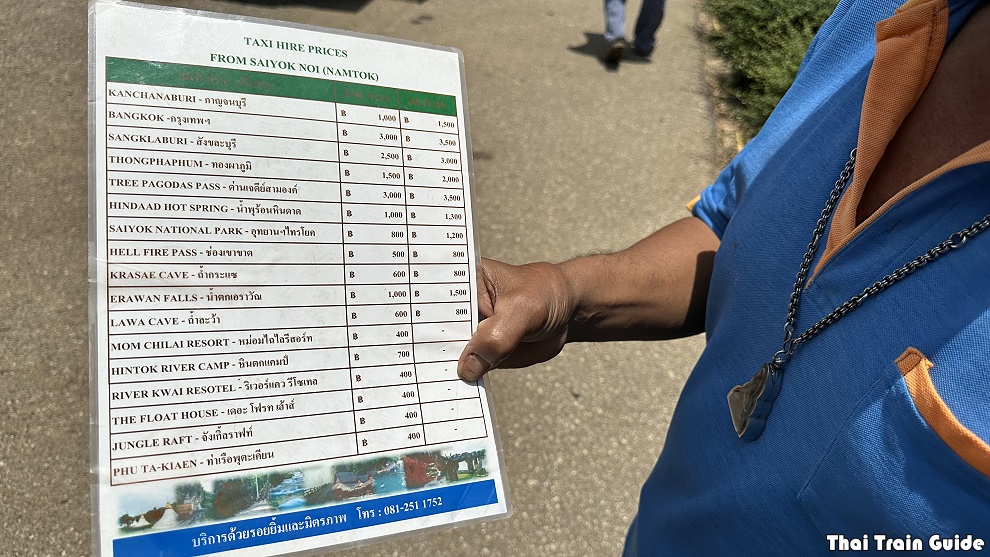
You also have the option to rent a songtaew to go wherever you want. For instance, a round-trip to Hellfire Pass costs 800 Baht. If you’re staying at a resort by the river, the songtaew driver can also take you there.
If you plan on returning by train, there are only two options available. The morning train, No. 258 departs at 1:00 p.m., giving you a mere 55-minute window. The next and final train, No, 486, leaves at 3:30 p.m., but it only goes as far as Kanchanaburi. If you choose the latter train, you’ll have approximately three hours, which should be enough time to visit Hellfire Pass. In case you miss the last train, there is a small hotel near the station. Alternatively, you can walk to the main road and catch any southbound bus heading back to Kanchanaburi.
RELATED LINKS:

